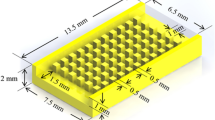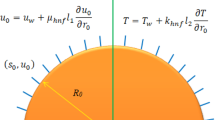Abstract
Burning rate of solid fuel and laminar flame spread rate are both well studied topics for flame spread in downward configuration. Yet, despite well-developed theories, not much experimental data is available to correlate the two. In this work, experiments are performed under ambient conditions in downward spread configuration for a wide range of thicknesses (2 mm to 24 mm) for flat samples of Poly-Methyl Methacrylate (PMMA). The samples are held by two ceramic plates in order to obtain a two-dimensional propagation that is independent on the sample width. By analyzing videos of the experiments, the instantaneous spread rate is obtained using a recently developed MATLAB based tool. The shape of the pyrolyzing fuel is carefully measured after extinguishing the flame during a steady propagation. The spread rate and the burn angle, which is defined as the angle subtended by the pyrolyzing surface with respect of the fuel surface, are correlated, producing an expression for the burning rate in terms of the burn angle and flame spread rate. As the fuel thickness is increased, the burn angle and burning rate decrease and reach asymptotic limits for thermally thick fuels, in analogy with the spread rate limit. The comparison with data from literature suggests that in the thick limit the value of mass flux for PMMA (about 10 g/m2 s) tends to the one of non-spreading flames. The presented geometrical approach to study the downward spread problem avoids the use of the B number and local gradients in order to calculate the mass burning rate of the fuel.








Similar content being viewed by others
References
Fernandez-Pello A, Williams F (1977) A theory of laminar flame spread over flat surfaces of solid combustibles. Combust Flame 28: 251–277
Sibulkin M, Lee CK (1974) Flame propagation measurements and energy feedback analysis for burning cylinders. Combust Sci Technol 9: 137–147
Williams F (1977) Mechanisms of fire spread. Proc Combust Inst 16(1): 1281–1294
Wichman I (1992) Theory of opposed-flow flame spread. Prog Energy Combust Sci 18: 553–593
de Ris J (1969) Spread of a laminar diffusion flame. Proc Combust Inst 12(1): 241–252
Delichatsios M (1986) Exact solution for the rate of creeping flame spread over thermally thin materials. Combust Sci Tech 44: 257–267
Emmons H (1956) The film combustion of liquid fuel. Z A Math Mech 36: 60–71
Spalding DB (1950) Combustion of liquid fuel in gas stream. Fuel 29: 2–7
Ndubizu C, Ananth R, Tatem P (2005) Transient burning rate of a noncharring plate under a forced flow boundary layer flame. Combust Flame 141: 131–148
Pizzo Y, Consalvi JL, Querre P, Coutin M, Audouin L, Porterie B, Torero J (2008) Experimental observations on the steady-state burning rate of a vertically oriented PMMA slab. Combust Flame 152(3): 451–460
Orloff L, de Ris J, Markstein GH (1975) Upward turbulent fire spread and burning of fuel surface. Symp Int Combust 15: 183–192
Singh AV, Gollner MJ (2015) Estimation of local mass burning rates for steady laminar boundary layer diffusion flames. Proc Combust Inst 35(3): 2527–2534
Ayani MB, Esfahani JA, Mehrabian R (2006) Downward flame spread over PMMA sheets in quiescent air: experimental and theoretical studies Fire Saf J 41: 164–169
Creeden JV (1974) Flame propagation rate measurements for downward burning PMMA sheets. Sc.M. Thesis Brown University, Providence
Bhattacharjee S, Carmignani L, Celniker G, Rhoades B (2017) Measurement of instantaneous flame spread rate over solid fuels using image analysis. Fire Saf J 91: 123–129
Bhattacharjee S, Laue M, Carmignani L, Ferkul P, Olson S (2016) Opposed-flow flame spread: a comparison of microgravity and normal gravity experiments to establish the thermal regime. Fire Saf J 79: 111–118
Laue M (2015) Experimental study of the effect of fuel thickness on opposed flow flame spread over PMMA. San Diego State University, San Diego
Lastrina F, Magee R, McAlevy R (1971) Flame spread over fuel beds: solid phase energy considerations. In: Thirteenth Symposium (International) on Combustion, p 935
Kulkarni AK, Kim CI (1990) Heat loss to the interior of a free burning vertical wall and its influence on estimation of effective heat of gasification. Combust Sci Tech 73(4): 493–504
Acknowledgements
This work was funded by the NASA ISS Research Project Office with Dr. David Urban serving as the contract monitor.
Author information
Authors and Affiliations
Corresponding author
Rights and permissions
About this article
Cite this article
Carmignani, L., Rhoades, B. & Bhattacharjee, S. Correlation of Burning Rate with Spread Rate for Downward Flame Spread Over PMMA. Fire Technol 54, 613–624 (2018). https://doi.org/10.1007/s10694-017-0698-3
Received:
Accepted:
Published:
Issue Date:
DOI: https://doi.org/10.1007/s10694-017-0698-3




